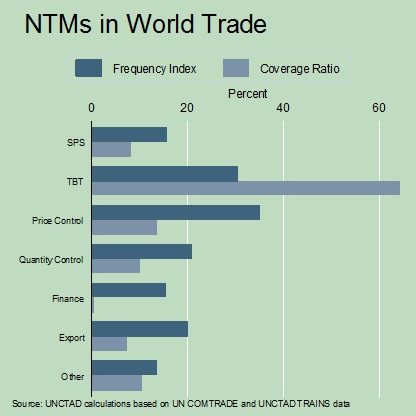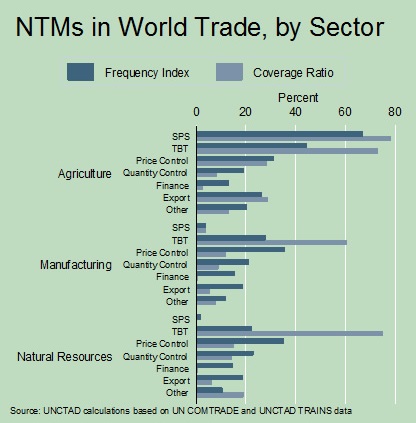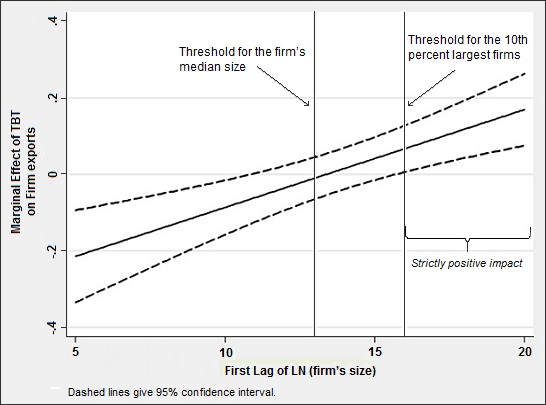News
The differentiated effects of non-tariff measures

Non-Tariff Measures (NTMs), and in particular technical regulations, are here to stay. Diversity of effects calls for a new policy paradigm.
Trade costs matter
A large number of empirical studies and surveys document the importance of trade costs as a factor determining the competitiveness of developing country-based enterprises and national trade performance. This includes not only export values but also participation in international production networks and diversification into new products and new markets. Strikingly, most trade cost components have fallen for all groups of countries but more slowly in low-income countries. Transaction costs remain high for countries with lower levels of per capita income[1]. As a consequence, these countries may have not been able to take up crucial trade, production and development opportunities.
Trade transaction costs consist of two broad categories. The first category encompasses exogenous factors such as geographic distance. The second category includes endogenous trade costs that are a direct consequence of policy choices. Standard trade policy instruments such as tariffs have been at the core of policy actions at both the multilateral and regional level for a long time. Overall results are mixed, and the scope for further significant tariff liberalization has shrunk in most countries and most sectors. The Trade Facilitation Agreement recently concluded by WTO members contains provisions on expediting customs procedures and cooperation between customs and other relevant authorities and is expected to reduce transaction trade costs. This is important and good news. However, it does not address another, probably even more important trade cost component.
NTMs, the new frontier
The new frontier for trade policy has shifted towards Non-Tariff Measures and in particular technical regulations (sanitary and phytosanitary (SPS) measures and technical barriers to trade (TBTs)). Figures 1(a) and 1(b) illustrate the distribution of NTMs across broad categories and sectors[2].
Figure 1: NTMs incidence


For each category, both the frequency index (i.e. the percentage of HS 6 digit lines covered) and coverage ratio (i.e. the percentage of trade affected) are reported. We observe that international trade flows are highly regulated through the imposition of technical barriers (TBT), with more than 30 per cent of product lines and almost 70 per cent of world trade affected. Quantity and price control measures affect about 15 percent, and sanitary and phytosanitary measures (SPS) about 10 per cent of world trade. When looking at the coverage of NTMs by broad category, one can observe that agriculture is the most affected, with the majority of world agricultural trade subject to SPS and TBT measures.
While technical regulations are not new trade policy instruments, they have become core determinants of market access opportunities especially for firms in developing countries. Recently published UNCTAD research shows that low-income countries’ exports of agricultural goods to EU markets are disproportionately negatively impacted by SPS measures.[3] The result is consistent with the hypothesis that market access is increasingly determined by the capability to comply with the regulatory framework and that countries at a lower level of development find themselves outcompeted. However such mechanisms may also be at work within any specific country.
Theoretical insights suggest that the effect of a technical regulation on export performance may depend on the size of a firm, provided that size is associated with (for instance) productivity, and hence with the ability to overcome the additional costs of exporting imposed by new technical regulations. In other words, not all firms will be able to cope with the higher costs of new technical regulations, be it a fixed cost of adaptation and/or a variable trade cost. Ongoing UNCTAD research on Peruvian firms exporting to Latin American Integration Association countries supports these theoretical insights.
Results indicate that technical regulations tend to push small firms away from world markets and leave the largest shares of exports to large multinational firms, further strengthening their global influence. Figure 2 shows the effect of technical barriers to trade on export value as a function of the size (measured by lagged total exports) of exporting Peruvian firms. The largest 10 per cent of Peruvian exporters are found to benefit from the implementation of a new TBT in LAIA destinations in terms of export value while the smallest 50 per cent are likely to lose.
Figure 2: The impact of TBTs on Firms’ exports

Note: estimates obtained for data on Peruvian firms exports to ALADI countries during the 200-2014 period.
Implications for policy
While technical regulations may impede exports and in particular exports of small and medium producers in developing countries, they are important instruments to achieve sustainable development. Technical regulations and standards have primarily non-trade objectives, such as public health and safety, and protecting the environment. It would be misleading to look at technical regulations as we look at tariffs. In light of the existing evidence more efforts have to be devoted to facilitate and possibly streamline the implementation of NTMs.
-
First, governments should ensure that NTM requirements are scientifically based. Public authorities should also accelerate the standardization process. Collaboration with private certifiers can play an important role in this process.
-
Second, developing countries’ concerns should be addressed specifically. The inclusion of these countries in the standard-setting process should be increased, and special attention should be paid to their small and medium firms. Intensifying technical assistance and capacity building activities in order to help developing countries and their exporters to fulfil NTM requirements is highly desirable. Special efforts should also be made in order to integrate these activities with national ones.
-
Third, in addition to technical assistance and capacity building programs, private sector based initiatives could also be contemplated to promote the participation of small and medium enterprises in export markets. Governmental and non-governmental organizations could instigate the establishment of cooperatives within which small and medium enterprises could exchange and collaborate on issues related to the compliance with technical regulations on international markets. Encouraging long term exporter contracts could also be useful.
-
Fourth, as leading firms in developing countries are key actors in driving compliance with standards, their active implication should be recognized by public authorities and non-governmental institutions.
-
Finally, systemic and systematic collection of relevant data should be placed at the core of political agendas at the national regional and international levels.
[1] Arvis, Jean-François & Shepherd, Ben & Reis, José Guilherme & Duval, Yann & Utoktham, Chorthip, 2013. “Trade Costs and Development: A New Data Set.” World Bank – Economic Premise, 104, pp1-4.
[2] Originally published in UNCTAD, 2015. “Key Statistics and Trends in Trade Policy 2015.”
[3] Nicita, Alessandro & Murina, Marina, 2015. “Trading with Conditions: The Effect of Sanitary and Phytosanitary Measures on the Agricultural Exports from Low-income Countries.” forthcoming in The World Economy.
Fugazza, Marco & Olarreaga, Marcelo & Ugarte, Christian, 2016. “Trading with Hurdles: Too Big to Stumble.” Policy Issues in International Trade and Commodities Research Studies Series #78, UNCTAD.




